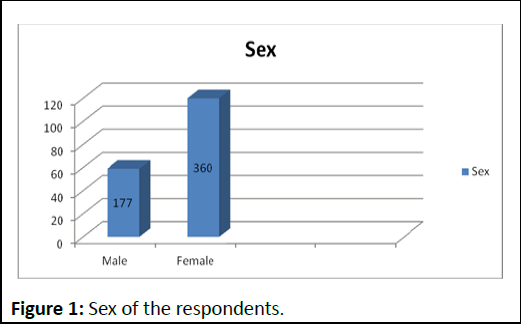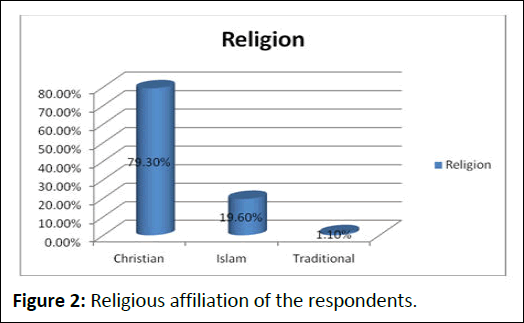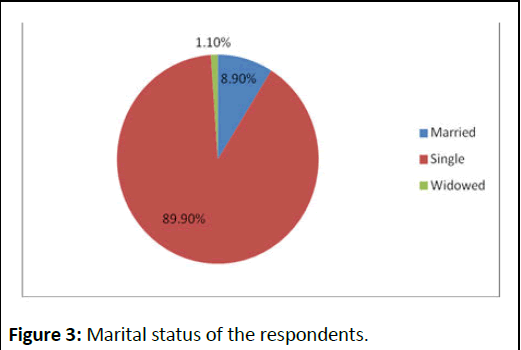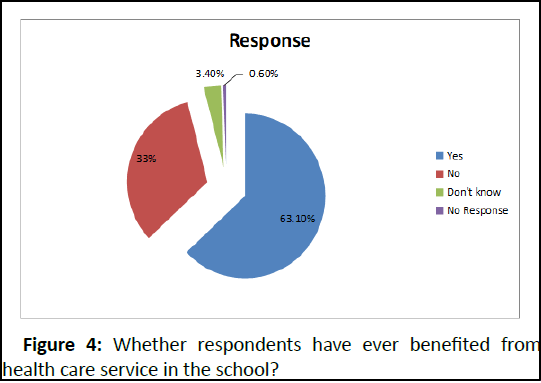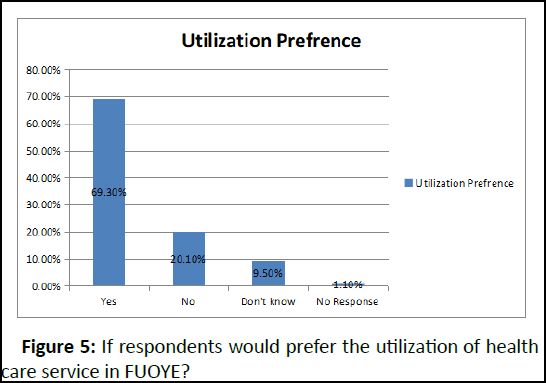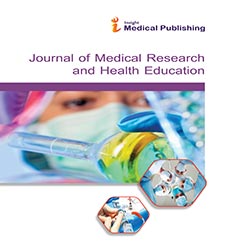Awareness, Knowledge, Embracement and Utilisation of Tertiary Institution Social Health Insurance Programme (TISHIP) among Undergraduate Students at Fuoye, Nigeria
Kolawole Taiwo Olabode1*and Owoeye Timilehin Peter2
1Department of Sociology, Federal University, Ekiti State, Nigeria
2Department of Health Education, University of Sunderland, Sunderland, United Kingdom
*Corresponding Author:
- Kolawole Taiwo Olabode
Department of Sociology, Federal University, Ekiti State, Nigeria
E-mail:kolawole1999@yahoo.com
Received date: November 08, 2023, Manuscript No. IPJMRHE-23-18108; Editor assigned date: November 13, 2023, PreQC No. IPJMRHE-23-18108 (PQ); Reviewed date: November 27, 2023, QC No. IPJMRHE-23-18108; Revised date: March 11, 2025, Manuscript No. IPJMRHE-23-18108 (R); Published date: March 18, 2025, DOI: 10.36648/2393-8862.9.1.33
Citation: Olabode KT, Peter OT (2024) Awareness, Knowledge, Embracement and Utilisation of Tertiary Institution Social Health Insurance Programme (TISHIP) among Undergraduate Students at Fuoye, Nigeria. J Med Res Health Educ Vol:9 No:1
Abstract
The empirical study focused on the awareness, knowledge, embracement and utilization of Tertiary Institution Social Health Insurance Programme (TISHIP) among undergraduate students at FUOYE, Nigeria. The specific objectives of the study are:
Methods: This study was carried out in four major campuses at Federal University Oye-Ekiti which include Oye, Ikole, Ilupeju and Itapa in Ekiti state Nigeria. A total of 537 undergraduate students were purposively sampled for the study. A mixed method was implored (semi-structured questionnaire and IDI) to collect both quantitative and qualitative data respectively. The quantitative data was
analysed using IBM SPSS version 20 while the qualitative data was analysed using content analysis and verbatim.
Results: On the demographic characteristics of the respondents, findings showed that 50.8% were within the age range of 20-24 years, 67.0% were female while only 33.0% were male, 79.3% were Christians, 89.9% were single, 31.3% were in faculty of social sciences and 53.1% were in 300 level. More so, 55.9% have heard or are aware of TISHIP scheme in FUOYE, 55.9% used school clinic to access health care, 63.1% have ever benefited health care service from the school health center/sick bay, 69.3% they prefer to
use the school health facility because it is capable to treat them well of any kind of illness, disease or sickness 59.2%supported this, 20.2% got to know about TISHIP during new students orientation programme and 74.9% define TISHIP as Tertiary Institution Social Health Insurance Programme.
Conclusion: The study concluded that management of FUOYE should as a matter of urgency endeavor to explore all avenues to create very strong awareness about the availability of TISHIP, its embracement and utilization among the students in order to improve healthy living environment conducive for learning.
Keywords
TISHIP; PMV; Tertiary institution; Quality of health; Health facility and sick bay
Introduction
The matter or issue of health is a global phenomenon and also everybody'?s concern. No wonder the saying that, â??When there is life, there is also hope''. Also, people do say, ''Health is Wealth''. Going by these two sayings, health is very crucial and paramount in the life of everyone and also in the nation at large. It then means, all necessary avenues must be explore by all stakes in order to ensure sound health for all and sundry so as to enhance global health standard especially in attaining the global SDGs. To this end, was the introduction of National Health Insurance Scheme (NHIS) especially for all government workers at thye Federal level before it was later extended to workers at state level with of course some condition to control the scheme. This scheme was later made extensive to students in all higher institutions in Nigeria. But the health scheme did not cover all programmes in Nigerian Tertiary institutions. For instance, Chibuke opined that, the study done in Ahmadu Bello University documented that initially TISHIP started with only regular students but now it covers all diploma, post graduate and nondegree students since they are all under Tertiary institution. In a retrospective assessment of the TISHIP at University of Jos Health Centre from 2010 to 2013 found that only the full time students were considered eligible and registered under the TISHIP [1]. This health scheme is called Tertiary institution Social Health Insurance Programme (TISHIP). This health scheme was introduced in order for government not to leave any stone unturned in the area of health knowing fully well that it will provide a healthy environment for all stakes in all institutions of learning in Nigeria. However, the awareness, knowledge, embracement/acceptability and utilization of this health scheme becomes a major issue in virtually all the Tertiary institutions of learning in Nigeria or put differently those institutions this type of study has taken place such as Nnamdi Azikwe University, Awka, Ahmadu Bello University, Zaria, University of Jos Health center, University of Abuja and Enugu state University [2-4]. It is indeed against this backdrop that this study intends to investigate or assess the awareness, knowledge, embracement and utilization of TISHIP among undergraduate students of Federal University Oye-Ekiti.
The population of every nation plays an important role in the economic growth and development of the state. To achieve this, the government of the nation at all tiers must come together to strategize on the modalities to control mortality rate and to ensure that all and sundry enjoys or benefits quality and sound health because good health is the concern of the global world especially World Health Organisations (WHO) and other global agencies. This gave rise to the health insurance scheme as the case in the developed nations. The need for the establishment of health insurance scheme which was informed by the generally poor state of the nation's healthcare sector in terms of operations and services to humanity, the excessive dependence and pressure on government provided health facilities, declining funding of healthcare in the face of rising costs, poor integration of private health facilities in the nation's healthcare delivery system and overwhelming dependence on out-of-pocket expenses to purchase health [5]. To Aniwada et al., argued that the National Health Insurance Operational Guidelines impelled the government of Nigeria at the federal level to initiate the search for other means of funding health care that had been neglected in the past [6]. Health insurance scheme is an alternative source of financing quality health care that has become important in the South world [7]. It has been implemented as part of health reform programs and strategies aimed towards providing quality, effective and efficient health care for all citizens, most especially for the poor and vulnerable. The National Health Insurance Scheme (NHIS) was established as a social security system based on social health insurance to ensure that enrollees have access to quality and effective healthcare. The aim of making everyone to have access to quality health in Nigeria was also extended to students in higher institutions of learning. The Federal health scheme for students is called Tertiary institutions Social Health Insurance Programme (TISHIP). It is a social security system whereby the healthcare of students in Tertiary institutions is paid from funds pooled through the contributions of students, government subsidies and mandates, charitable and philanthropic organizations. It is an arm of the National Health Insurance Scheme (NHIS), which provides quality healthcare to students in Nigerian higher institutions. The purpose of TISHIP is to cater for the health care needs of Nigerians, aged 18 years and above, within Tertiary institution, who by nature of their age and studentship status, cannot benefit under other health insurance programme. Students are among the dependent population, may fall sick while in school and this if not promptly and appropriately managed negatively affects their academic performance. Taking care of their healthcare services is an enormous financial burden both on the students and on their parents and guardians. This prompted the government to introduce the TISHIP programme to Tertiary institutions in Nigeria to cushion this economic burden [8].
The programme according to precious healthcare is committed to ensuring access to qualitative healthcare service for students of Tertiary institutions thereby promoting the health of students with a view to creating conducive learning environment. Extensive evidence is now available to demonstrate the link between health, as well as school health programs to academic achievement. Some institutions have existing network of quality in-house health schemes. Such commendable in-house arrangement is fully integrated into TISHIP scheme. An actuarial review has been carried out by National Health Insurance scheme (NHIS) and N1,600:00 per annum was recommended as minimum premium to be paid by every student in Tertiary institution. On the contrary, this above benchmark of N1,600 is no longer applicable in virtually all Tertiary institutions. For instance, at Federal University Oye- Ekiti, the current 100 level students of 2019/2020 academic session paid N10,000 for medical while the present 300 level students paid N5,000 for medical 3 years ago.
The health scheme is actually meant to provide every student in Tertiary institutions the unlimited access to good and quality health services, protect students and families from the financial hardships of huge medical bills, maintain high standard of healthcare delivery services within Tertiary institutions and ensure availability of funds to the Tertiary institution health centres for improved services.
However, it is noteworthy that many students are not aware of the TISHIP program and those who are sensitized about it still doubt about the authenticity of the program and this limits their participation. Also, not every student in Tertiary institution are been covered. Also, the utilization of Health Insurance Scheme services varies across different cultures for a variety of reasons but it appears that the determining factors are universal. It is determined not only by its availability but by a number of other factors including; location and distance to facility, accessibility, client's perception of services, self-rated health status, providerrelated factors, income and education level [9].
A study on the perception of students to factors affecting the utilization of health services in Tertiary institutions in South-Western Nigeria, factors identified includes; inadequate referral services, high cost of drugs, time spent in waiting for treatment, satisfaction with services and non-availability of essential drugs.
Accessibility to health facility and students medical staff relationship, however, were not considered to be factors affecting utilization of university health services [10].
The level of awareness and utilization of TISHIP in various Tertiary institutions in Nigeria is uncertain because there is not enough research done on the use of the programme. Based on this, this study will re-assess the level of awareness and utilization of TISHIP and possible constraints to its usage and possibly suggest workable means of achieving the set target of persons enrolled into the insurance scheme.
Objectives of the study
The specific objectives of this study are to:
• Examine the level of TISHIP awareness among the undergraduate students at FUOYE.
• Investigate the knowledge and embracement of TISHIP among the undergraduate students at FUOYE.
• Explore the rate of TISHIP utilization among undergraduate students at FUOYE.
Significance of the study
Studies from different scholars and at diverse time have shown variance results in respect to the introduction and use of TISHIP among undergraduate students from different Tertiary institutions in Nigeria. Past studies showed that the introduction and use of TISHIP was in old institutions such as Ahmadu Bello University, Zaria, University of Enugu, Abuja University among others. This study focused on four major variables which include awareness of TISHIP among students, knowledge of TISHIP, acceptability of TISHIP and the use of TISHIP in one of the Federal Universities established by the administration of Goodluck Ebele Jonathan in 2011. This study is very relevant in order to measure the above mentioned variables in relation to TISHIP introduction in this new institution. The old Universities stated above by every standard cannot be compared to FUOYE. For instance, when you talk of population of students and staff, land capacity, infrastructures, capital base and sources of IGR and international exposure and the like. All these in one way or the other play a good role for the introduction and operations of TISHIP for the benefits of the students. Therefore, it becomes imperatives for this study to assess the introduction and use of TISHIP among undergraduate students in FUOYE using sociological mirror in the areas of awareness, knowledge, acceptability and untilisation in a new institution. Also, of significance, this study will fill all existing lacuna from previous studies and unravel the operations of TISHIP at FUOYE and pave way for other scholars for future studies [11].
Materials and Methods
Research methodology
This study is a descriptive in every sense. The study was carried out in four campuses at Federal University Oye-Ekiti (FUOYE) Nigeria. The study used mixed methods. That is, both qualitative and quantitative data. The qualitative data was carried out by conducting In-depth Interview (IDI) with the staff of Health center at FUOYE to elicit information on the operations of TISHIP for students and also the issue of referral should there be need. The quantitative data was done via the administration of semi-structured questionnaire to students across all the existing campuses in FUOYE to elicit data on the awareness, knowledge, embracement and utilization of TISHIP among the students.
Selection of sample
The sample size for this study is 537 as against 600 (89.5%) undergraduate students which cut across Pre-Degree students in Itapa-Ekiti, JUPEB students in Ilupeju-Ekiti and undergraduate students in Ikole-Ekiti and Oye-Ekiti campuses, all in Ekiti State, Nigeria. The sample size was purposively selected from all the campuses base on the population of students for each programme the campuses run. That is, the sample size in Oye- Ekiti (main campus) was 300 students, Ikole-Ekiti campus was 200, Ilupeje-Ekiti and Itapa-Ekiti 50 students from each campuses. The issue of discourse (health) concerns all the students in all the campuses. It should be noted that out of the 600 questionnaires administered, a totally of 537 questionnaires were well filled for analysis which 89.5% (Table 1).
| Programme | No. of students | No. of faculties |
|---|---|---|
| Undergraduate Main Campus Oye-Ekiti | 300 | 8 |
| Undergraduate Satellite Campus Ikole-Ekiti | 200 | 3 |
| Pre-Degree Programme Itapa-Ekiti Campus | 50 | 1 |
| Joint Universities Preliminary Examinations Board (JUPEB) Programme Ilupeju-Ekiti Campus | 50 | 1 |
| Total | 600 | 13 |
Table 1: Programme according to students and faculties.
Results
From the Table 2, majority of the respondents 50.8% were within the age range of 20-24 years, 31.8% were 25-29 years while 16.8% of the respondents were 15-19 years and only 0.6% were 30 years and above. This simply implies that most of the students in Tertiary institutions are relatively young. Also, it should be noted that some adults still have interest in developing themselves in order to compete with their counterparts favorably anywhere in the world. The mean of the age of the respondents is 22.81.
| Age range | Frequency | Percentage |
|---|---|---|
| 15-19 years | 90 | 16.8 |
| 20-24 years | 273 | 50.8 |
| 25-29 years | 171 | 31.8 |
| 30 years and above | 3 | 0.6 |
| Total | 537 | 100 |
Table 2: Age of the respondents.
Figure 1 is on the sex of the respondents. Majority of the respondents 67.0% were female while only 33.0% were male. This indicates that more female participated in this study than their male counterpart. Also, the study seems to be friendlier to female than male which is contrary to previous study carried out in Jos indicate that most of the respondents were male (67.0%), with female ratio of 2.1. This is in contrast with the study of Sanusi and Awe.
Figure 1: Sex of the respondents.
The religious affiliation of the respondents. Most of the respondents 79.3% of the respondents were Christians, 19.6% of the respondents were Islam while 1.1% of the respondents were traditional religion practice. This indicates that most of the students in FUOYE that participated in the study were Christians because Southwest is Christians dominated area. It is important to note that traditional religion still has followers even with the rapid growth in science and technology (Figure 2).
Figure 2: Religious affiliation of the respondents.
The pie chart is on the marital status of the respondents. Majority of the respondents 89.9% were single, 8.90% of the students were married while only 1.10% of the respondents were widowed. It can be said that close to 90.0% of the students in Tertiary institutions are single who never married. Also, Tertiary institutions have virtually all categories of marital statuses, among the students although they may be very few or very insignificant in number (Figure 3).
Figure 3: Marital status of the respondents.
The Table 3 is on the faculties of the respondents. Majority of the respondents 31.3% were in faculty of social sciences, 13.4% were in faculty of management science, 11.7% of the respondents were in faculty of science, 11.2% of the respondents were in faculty of engineering while only 5.0% of the respondents were in faculty of law. The above distribution showed that the students in different faculties participated in the study. That is, all the existing faculties in FUOYE were represented in this study.
| Faculty | Frequency | Percentage |
|---|---|---|
| Agricultural | 57 | 10.6 |
| Engineering | 60 | 11.2 |
| Social sciences | 168 | 31.3 |
| Sciences | 63 | 11.7 |
| Education | 45 | 8.4 |
| Management sciences | 72 | 13.4 |
| Art | 45 | 8.4 |
| Law | 27 | 5 |
| Total | 537 | 100 |
Table 3: Faculty of the respondents.
Table 4 is on the level of the respondents. A large number of the respondents 53.1% were in 300 level, 29.6% of the respondents were in 400 level, 10.6% of the respondents were in 200 level while only 2.6% of the respondents were in 500 level. It means students in virtually all the levels of the departments in FUOYE participated in this study. It is noteworthy that 100 level students were deliberately excluded from the study because they are new in the system. They are likely not to have knowledge of what the study is all about.
| Level | Frequency | Percentage |
|---|---|---|
| 200 | 57 | 10.6 |
| 300 | 285 | 53.1 |
| 400 | 165 | 29.6 |
| 500 | 36 | 2.6 |
| Total | 537 | 100 |
Table 4: Respondent’s level.
TISHIP awareness and knowledge among the students
The Table 5 focuses on the different options where respondents seek healthcare whenever it is needed. A good number of the respondents 55.9% access health care through school clinic/sickbay, 14.5% of the respondents said they have never been sick, 13.4% of the respondents access health care through Patent Medicine Vendor (PMV) outside of the school 10.1% access health care in private hospital outside the school while only 6.1% of the respondents access health care via state government hospital outside the school. From the above it showed that more than half of the student’s population is aware of the school sickbay and they access health care there whenever they are sick perhaps because they do not have the money to pay for their health bill if they go outside of the school for health treatment. It is noteworthy that 29.6% of the student’s population prefer to seek for health care outside of the school from different facilities probably because they have money to pay for their bill or the health challenge can be better taking care by health personnel outside the school. It is also important to discover that 13.4% of the students prefer to do self-medication by visiting PMV for different drugs. This indeed is very dangerous. On the divergent, previous studies revealed that students barely visit institutions’ health care facilities due to high costs of medical services, poor working conditions and inadequate referral services most of which TISHIP address.
| Health care options | Frequency | Percentage |
|---|---|---|
| School clinic | 300 | 55.9 |
| State government hospital outside the school | 33 | 6.1 |
| Private hospital outside the school | 54 | 10.1 |
| Patent medicine vendor outside the school | 72 | 13.4 |
| Never been sick | 78 | 14.5 |
| Total | 537 | 100 |
Table 5: Where respondents access health care?
Extract 1: In-depth interview with a staff in HNIS unit in FUOYE health centre: Student are aware of the scheme, as the clinic is mostly populated by student as a result of the TISHIP scheme since it cover all aspect of health (free care), and in terms of knowledge of the scheme, this is passed down by personnel during orientation of the students so that they could have basic knowledge of the program and to benefit from it.
When asked what are the awareness strategies?
Some of the strategies to create awareness include (i) Educating fresh student during their orientation program which is mostly anchored by the director. (ii) Distribution of hand-bills and (iii) Committee within the grass-root e.g. Student Union (S.U).
The Figure 4 whether respondents have ever benefited from school health care service? The chart displayed that majority of the respondents 63.1% said yes, they have ever benefited health care service from the school, 33.0% of the respondents said No, they have not benefited health care service from school while 3.4% of the respondents said they don’t know while 0.5% of the respondents did not respond to the question. It can be concluded that most of the students use and benefit health care service from the school clinic or sickbay.
Figure 4: Whether respondents have ever benefited from health care service in the school?
Figure 5 measure the utilization preference of FUOYE health facility by the respondents. From the chart, 69.3% of the respondents said Yes, they prefer to use the school health facility, 20.1% of the respondents said No, they will not want to use FUOYE health facility while only 9.5% of the respondents said they don’t know. This simply indicate that a large sum of the entire students at the federal university oye-Ekiti ultimately prefer to use the health facility present in the school for whatever health challenge they may have.
Figure 5: If respondents would prefer the utilization of health care service in FUOYE?
Table 5 is on if the school health care’s facility is capable to provide adequate health to respondent’s health issue. Most of the respondents 59.2% said yes, the school health clinic or sickbay is capable to treat them well, 29.1% of the respondents said No, the school health center or sickbay is not capable to adequately treat their health issue while only 11.2% said don’t know. From the above analysis, the school health center or sickbay in terms of manpower, administration and health equipment is very competent to treat any students irrespective of their health challenge. A few among the students probably that come from affluent homes or who have stigmatized health issue feel the school health center or sickbay is not capable to treat or handle their health challenges because it is not a fully equipped health facility.
| Response | Frequency | Percentage |
| Yes | 318 | 59.2 |
| No | 156 | 29.1 |
| Don't know | 60 | 11.2 |
| No response | 3 | 0.6 |
| Total | 537 | 100 |
Table 6: Whether respondents think school health care is capable of proffering solution to their health issue?
Table 6 focuses on whether respondents have heard of TISHIP programme or scheme. Majority of the respondents 55.9% said yes, they have heard of TISHIP scheme, 41.3% of the students said no, they have not heard of TISHIP, 1.7% of the respondents said they don’t know while 1.1% of the respondents did not respond to the question. From the foregoing, more than half of the students have heard of TISHIP scheme. It is important to note that 43.0% of the students have not heard of TISHIP simply because they have no course to enjoy it or they do not have friend who have enjoyed it that could tell them about it. This simply means that the awareness for TISHIP is not enough, it has not gone round the whole campuses for the students the scheme is meant for. To corroborate this finding, the study on TISHIP by Vambe et al., showed that undergraduate students are not aware of the health insurance scheme which over the years has been modified and still in a constant flux. This means the awareness of TISHIP among students in higher institutions is like a flowing stream that becomes more modified into a reverse of its new form. Therefore, management of all higher institution should endeavor to keep the awareness programme on putting in place all measures available until all students knows about the existence of the health scheme programme, in other to promote quality health on campus. Also, Aniwada et al., has this to say it is noteworthy that many students are not aware of the TISHIP program and those who are sensitized about it still doubt about the authenticity of the program and this limits their participation.
| Response | Frequency | Percentage |
|---|---|---|
| Yes | 300 | 55.9 |
| No | 222 | 41.3 |
| Don't know | 9 | 1.7 |
| No response | 6 | 1.1 |
| Total | 537 | 100 |
Table 7: If respondents have ever heard/are aware of TISHIP?
Table 7 is on respondent’s sources of TISHIP. From the table, 20.2% of the respondents got to know about TISHIP during orientation programme, 14.5% got to know about TISHIP through friends, 12.3% know about TISHIP through media, 11.2% of the respondents know about TISHIP while at the school clinic while only 2.8% of the respondents got to know about TISHIP when they took a friend or someone to the school clinic. This simply means there are many sources through which respondents got to know about TISHIP in FUOYE. This indicates that the school management needs to explore all necessary legitimate avenues to bring TISHIP to the notice of all students starting from their individual departments to faculties and other channels. However, it is important to note that 39.1% of the respondents don’t know TISHIP. This is indeed a very large population of FUOYE students who do not know anything about TISHIP. Since all students at entry point pay for health, they should all know all the schemes or health packages that the school management has in place for them whether they choose to explore it or not. The school management should bridge the awareness gap about TISHIP in the school.
| Options | Frequency | Percentage |
|---|---|---|
| Friends | 78 | 14.5 |
| During orientation | 108 | 20.2 |
| While at the school clinic | 60 | 11.2 |
| Information media | 66 | 12.3 |
| When I took a sick friend/someone to the school clinic | 15 | 2.8 |
| Don't Know TISHIP | 210 | 39.1 |
| Total | 537 | 100 |
Table 8: Respondents sources of knowing about TISHIP?
The meaning of TISHIP was explored in the above table. From the table, majority of the respondents 74.9% define TISHIP as Tertiary Institution Social Health Insurance Programme, 12.3% sees it as Tertiary Institution Students Health Insurance Programme while only 1.7% of the respondents said it is Today's Institution Students Health Insurance Programme and 5.0% did not respond. This simply means that most of the students know the accurate meaning of what TISHIP is even though they may not avail themselves the usage of the health scheme in the school (Table 8).
| Response | Frequency | Percentage |
|---|---|---|
| Tertiary institution social health insurance programme | 402 | 74.9 |
| Today's institution students health insurance programme | 9 | 1.7 |
| Today's institution social health insurance programme | 33 | 6.1 |
| Tertiary institution students health insurance programme | 66 | 12.3 |
| No response | 27 | 5 |
| Total | 537 | 100 |
Table 9: What is the meaning of TISHIP?
An extract 2: In-depth interview from a staff of NHIS unit FUOYE health centre
When asked what do you understand by TISHIP?: It’s a tertiary institution social health insurance program for the students, provided as a form of insurance established by the federal government to help them in aspect such as cost of health, and an egalitarian health care delivery as well as providing probation for secondary referrer of which the scheme covers.
Figure 6 is on the basic knowledge of TISHIP health scheme. A large portion of the respondents 43.0% said yes, they have basic knowledge of TISHIP, 40.8% said no while only 10.1% of the respondents said don’t know and 6.1% did not respond to the question. This implies that less than half of the respondents have basic knowledge of TISHIP health scheme. As a matter of urgency, awareness on the existence and benefits of TISHIP health scheme is inevitable among the students.
Figure 6: If respondents have basic knowledge of the TISHIP scheme?
Conclusions
• It was observed that majority of the respondents 55.9% said yes, they have heard or are aware of TISHIP scheme in FUOYE.
• It was also observed that 55.9% of the respondents used school clinic to access health care.
• Most of the respondents 63.1% said yes, they have ever benefited health care service from the school health center/ sick bay.
• A large portion of the students 69.3% said Yes, they prefer to use the school health facility.
• Most of the respondents 59.2% said yes, the school health clinic or sickbay is capable to treat them well of any kind of illness, disease or sickness.
• A large part of the students 20.2% got to know about TISHIP during new students orientation programme.
• Majority of the respondents 74.9% define TISHIP as tertiary institution Social Health insurance programme.
Recommendations
• It is suggested that management of FUOYE should explore all available sources to make students be aware of the introduction of TISHIP.
• Every student should make to know that TISHIP is their health benefit which must be explore any time the need arises.
• Management should give all students their TISHIP code immediately they resume school.
• All students should be discouraged from attending private health facility where they exploit them without limit.
References
- Agbo HA, Okoh EO (2014) Assessment of the Tertiary institution social health insurance programme at the university of Jos health center. J Biol Chem Res 31:253-259
- Anetoh MU, Jibuaku CH, Nduka SO, Uzodinma SU (2017) Knowledge and implementation of Tertiary Institutions’ Social Health Insurance Programme (TISHIP) in Nigeria: a case study of Nnamdi Azikiwe University, Awka. Pan Afr Med J 28:171
[Crossref] [Google Scholar] [PubMed]
- Shagaya YJ (2015) Assessment of student’s satisfaction and quality of patient care under the Nigerian Tertiary Institutions Social Health Insurance Programme (TISHIP). Eur J Bus Manag 7:19-30
- Vambe TJ, Okafor IJ, Nweke OI (2019) Awareness and patronage of the Tertiary Institutions Social Health Insurance Programme (TISHIP) among students of Tertiary institutions in Abuja, Nigeria. Glob J Appl Manage Soc Sci 17:32-37
- Olanrewaju T (2011) National Health Insurance Scheme: Of what benefit to Nigerian masses. Nigerian Tribune Monday, 21
- Aniwada EC, Ndu AC, Okoye CJ, Okoye PC, Okpala AC, et al. (2019) Utilization of Tertiary Institutions Social Health Insurance Programme (TISHIP) among undergraduate students in Enugu State. Niger J Med 28:413-422
- Arnold G (1985) Aid and the Third World: The North/South Divide. Printed by Robert Royce Ltd, Great Britain.
- Adibe MO, Udeogaranya PO, Ubaka CM (2012) Awareness of National Health Insurance Scheme (NHIS) activities among employees of a Nigerian University. Int J Drug Dev Res 3:78-85
- Nora NA (2005) Factors affecting the choice of maternal and child health services in rural area in Saudi Arabia. Eastern Mediterr Health J 1:261-269
- Obiechina GO, Ekendo GO (2013) Factors affecting utilization of University health services in a Tertiary institution in South-West Nigeria. Niger J Clin Pract 16:454-457
[Crossref] [Google Scholar] [PubMed]
- Chibuike NE (2012) Evaluation of National Health Insurance Scheme (NHIS) awareness by civil servants in Enugu and Abakaliki. Int J Med Med Sci 5:356-358
Open Access Journals
- Aquaculture & Veterinary Science
- Chemistry & Chemical Sciences
- Clinical Sciences
- Engineering
- General Science
- Genetics & Molecular Biology
- Health Care & Nursing
- Immunology & Microbiology
- Materials Science
- Mathematics & Physics
- Medical Sciences
- Neurology & Psychiatry
- Oncology & Cancer Science
- Pharmaceutical Sciences
